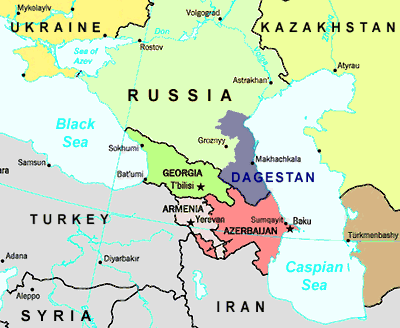Crisis in the Caucasus

History of the conflict in Dagestan
by Sarah K. Miller |
This article was posted on August 19, 1999.
Related Links
The Crisis in Dagestan Unfolded in 19997-8 Aug. 8 Aug. 10 Aug. 13 Aug. 16 Aug. International agencies announce that up to 10,000 refugees may have already been forced from their homes and are moving towards the Eastern Caspian Seacoast. 17 Aug. 18 Aug. 19 Aug. Basayev readies militants for a second stage of operations. 20 Aug. 23-24 Aug. 24 Aug. 31 Aug. Russian Defense Ministry reports that militants are concentrated in the Novolakskoye region of Chechnya on the Dagestani border. 1 Sept. 4 Sept. 5 Sept. |
Chechnya and Grozny returned to the headlines as Southwest Russia was once again consumed by crisis. This time the fighting erupted in the Russian Republic of Dagestan, Chechnya's eastern neighbor.

Geography
Dagestan is a Muslim republic, home to more than 36 nationalities in addition to Russians transplanted during the Soviet era. The Republic is mostly mountainous, and although its mineral and oil potential remains untapped, it has strategic importance due to its location on the oil-rich Caspian Sea and its close proximity to Azerbaijan, a main conduit for Caspian oil.
History of Russian control
Russia originally annexed Dagestan in 1813, although the inhabitants resisted Russian domination throughout the nineteenth century. The country was absorbed by the Soviet Union in 1920 and became an autonomous republic in 1921. After the breakup of the Union in 1991, Dagestan became a signatory to the March 1992 Treaty of Federation which created a new Russian state. As such, Dagestan is legally a Russian republic and a member of the Russian Federation.
The Current conflict
Unlike in the 1994-96 Chechen Civil War, which placed the Russian Federation against the entire Chechen breakaway Republic, the governments of Dagestan and Chechnya do not sponsor the Chechnya-based rebels led by the former Chechen separatist Shamil Basayev and a Jordanian Islamic militant known as Khattab. According to Russian sources, the rebels are a small, internationally funded militia whose numbers include Arabs and Africans as well as Dagestanis and Chechens.
In response to the rebels —who have declared Dagestan's independence and a holy war against Russia— Chechen Prime Minister and former separatist Aslan Maskhadov has announced a state of emergency in Chechnya, increasing the Chechen army's ability to monitor the rebels. Dagestan's Islamic leaders have called the rebels traitors to Islam, while the government has begun to evacuate the Botlikh district where the fighting erupted.
'No compromise' policy
Despite the recent reshuffling of the Russian government, President Boris Yeltsin has kept his "no compromise" policy, saying that he will never give up Dagestan. Each of the key Russian "Power Ministries" —the Defense Ministry, Foreign Ministry and Security Services— has been excluded from the reorganization, allowing for continuity of leadership.
In a telling move, Yeltsin replaced Prime Minister Sergei Stepashin with the experienced Federal Security Service and National Security Head Vladimir Putin, a hardened ex-KGB official who has pledged to crush the rebels.
What next?
Taking the lead from NATO bombings in Kosovo, Russia initially relied on its air offensive capabilities to combat the rebels. But, by mid-August ground forces were introduced and subsequently reinforced with more advanced paratrooper, motor-rifle, and artillery units in early September. Despite the initial success of the air and ground offensive against Basayev, it has had terrible repercussions upon the populace. As in Kosovo, the risk to non-combatants looms large in such an operation. On August 9, Russian planes accidentally dropped mines on the Georgian village of Zemo Omalo, close to the Georgian-Dagestani border.
Meanwhile, refugees continue to pour out of the Western districts of Dagestan. Although international aid organizations have noted the high number of refugees, they have indicated their inability to provide their services due to the high instance of kidnapping in the region. In the past, the rebels have not hesitated to kidnap or execute relief workers, journalists, or foreign nationals.
Russian military sources expect that 10-15,000 Russian troops may be called in to defeat the guerillas, estimated to number about 2000. The rebels, however, are relatively well equipped, and enjoy a strategic advantage from their mountain posts. Despite Russian assurances that the fighting would end quickly, Putin's claims of success were premature; the rebels have regrouped and the violence has spread across the Dagestani border into Chechnya perhaps re-igniting that cinder box once again. Regardless of the outcome, the evidence suggests that the conflict is far from over.







